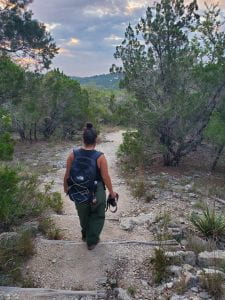Written by Wren Conner

Morning on the trail at Wild Basin.
This fall, I am interning as an Ecological Research Assistant at the Wild Basin Creative Research center. We are performing research on songbirds, particularly the Carolina Chickadee and Black Crested Titmouse. Our research centers around noise playbacks- to avoid getting too into the complicated details, we find the birds in the field, play certain noise via a speaker, and then observe and collect data on the birds’ various responses to the noise. Dr. Proppe, who is leading the research, has done a large amount of noise-related research on songbirds in the past, and birds are a huge passion of mine, so it’s a huge honor to be part of some research and I am so excited about the experience I am gaining collecting field data for this experiment!
My days start very early- I wake up around 5:30AM, since the best time to go looking for birds is when they’re most active- in the early morning! Most of the playbacks we have done so far have been at the Wild Basin preserve, but over the course of the internship we’ll be going to many Balcones Canyon Preserve locations. It’s a wonderful feeling to watch the sun rise at Wild Basin so early in the morning, and the mornings are just starting to cool down, so it’s great to be out and about- I look forward to going to more BCP properties in the future!

A morning at Wild Basin with my intern partner, Ava Enriquez!
We conduct the experiment in pairs, and my partner is a fellow intern, Ava Enriquez (pictured left). The two of us arrive around 7AM, and collect the equipment we need to perform our experiments, then head out into the field. Once we are in the field, we search for Black-crested Titmice and Carolina Chickadees. I personally am very knowledgeable on birdsong, so I do a lot of listening and looking for our birds. In fall and winter, less birds are singing, but the Carolina Chickadee and Black-crested Titmouse both have distinct songs. The Carolina Chickadee sings a sweet song of “fee-bee fee-bay,” and the Black-crested Titmouse has two songs: a “here, here, here!” song, and a two-note “peter, peter, peter!”

Ava and I set flags with a 10M rope for our experiment perimeter.
Because it’s winter, though, we often hear the calls rather then the songs. Both the Black-crested Titmouse and Carolina Chickadee call a distinct, memorable- “Chicka-dee-dee-dee!” -a call gives the Chickadee it’s name. The Black-crested Titmouse is in the same family as the Chickadee, Paridae, and shares its call, though not the name. Most of the time in the field, we rely on that distinct Chickadee call to find them, following the soft “chip” calls many birds make until they make a noise that distinguishes them as one of our target species.
Once we have located one of the birds we are studying, we begin the setup for our experiment. Our data requires us to be aware of the proximity of the birds to the speaker we are using to play our stimulus, so we have to set up a perimeter for our experiment. We do this by using a 10M long line of rope, then setting a flag at 10 meters in four directions from our speaker. This allows us to create our perimeter and start our experiment. We start our speaker, start our timers, and get as far away as we can while still being able to accurately observe the reactions to our playback. This is the hardest part of the process, since sometimes we are crawling through thorns and weeds to get to a space where we can observe without interfering with the experiment’s results.

Collecting field research observations on our data sheet.
The last part of our experimental process is the observation stage. This lasts 6 minutes- 1 minute before the experiment actually starts for us to get into position, then another minute of pre-playback, where we observe how the birds are behaving before the experiment starts. Then, the playback begins, which will last 1-2 minutes. We observe bird auditory and visual responses during this time as well. Once the playbacks end, we have an additional 2 minutes of post-playback, where we observe any additional bird response. Then, once we finish that, we mark the location on our map, pick up our speaker and flags, and move to our next playback location.
I have had an amazing time working on this project so far, and I’m so excited to continue my work on it. I would love to continue working on research at Wild Basin beyond this experiment, since I’m very passionate about ecological research and it’s a real goal of mine to do even more avian research in the future. I’m very thankful to Dr. Proppe and the Wild Basin Creative Research Center for the opportunity to work on this research, and I encourage anyone who is interested to come to Wild Basin or view the SEU website section on Wild Basin to learn more about the preserve and the great research that is being done there.